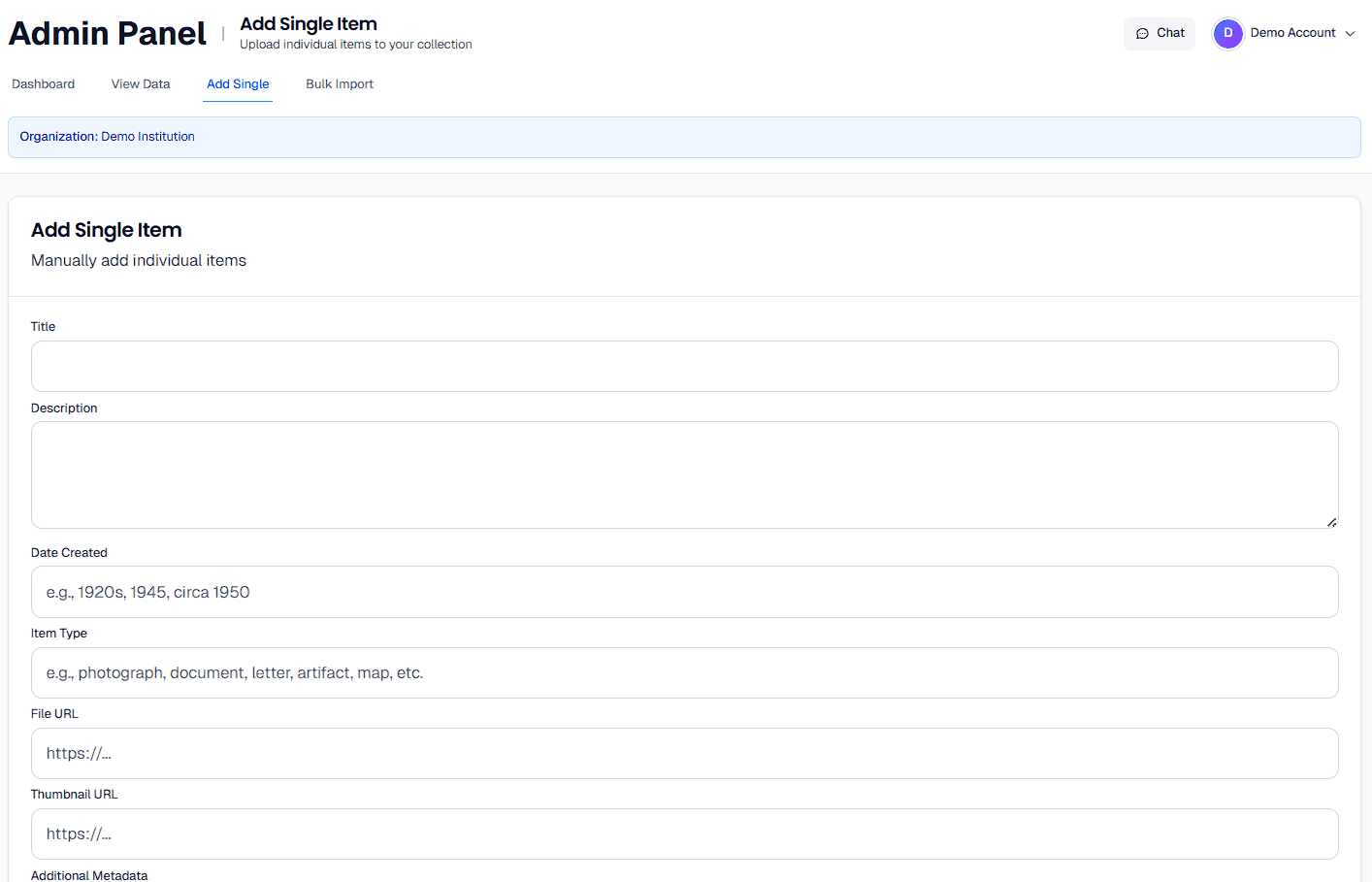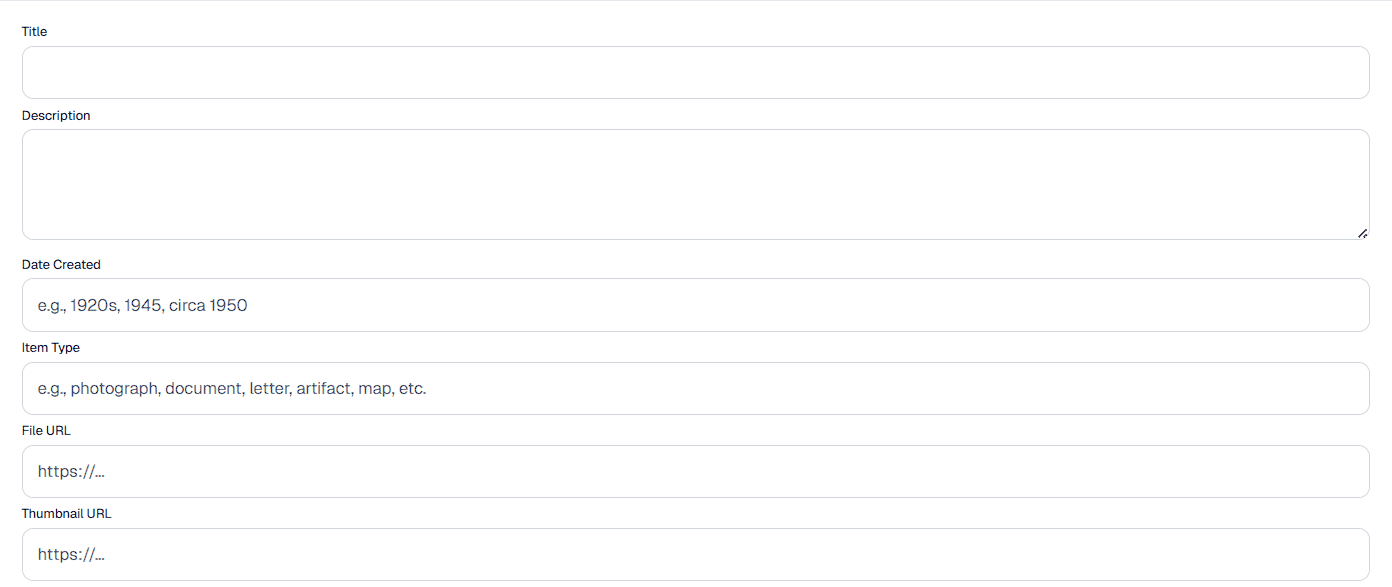How to Add Individual Items
Learn how to carefully craft individual archive entries with rich metadata, custom fields, and proper categorization for high-quality collection building.
When to Use Single Upload
Single upload is perfect when you need precise control over each item's metadata, when working with unique or complex items that require individual attention, or when adding items that don't exist as digital files but need to be cataloged and made discoverable.
🎯 Perfect Use Cases
Physical items: Books, artifacts, or documents that exist physically but need digital catalog entries
External resources: Items hosted on other websites or digital collections that you want to link to
Complex metadata: Items requiring detailed, custom metadata fields that need individual attention
Quality focus: When you want to ensure each item meets high standards before adding to the collection
⚡ Quick Overview
The process is straightforward: fill in the basic information fields, add as many custom metadata fields as needed, and submit. The system automatically generates searchable content and creates proper archive entries. You can always come back and edit items later through the Data Management interface.

Creating Quality Archive Entries
Crafting Essential Information
The basic information fields form the foundation of your archive entry. Take time to write clear, descriptive content that will help researchers understand and discover your item.

Required Fields
Title
The name or title of the item (required field)
Optional Fields
Description
Multi-line detailed description of the item
Date Created
Flexible date format (e.g., "1920s", "1945", "circa 1950")
Item Type
Category like "photograph", "document", "letter", "artifact"
File URL & Thumbnail URL
Links to external files or images
Additional Metadata System
Add unlimited custom metadata fields using the dynamic metadata system with predefined and custom field options.

Predefined Fields
Choose from a dropdown of standard metadata fields:
- • Based on TARGET_FIELDS mapping system
- • Only shows unused fields
- • Read-only field names for consistency
- • Structured field organization
Custom Fields
Create your own metadata fields for unique data:
- • Free-text field names
- • Automatic "metadata." prefix formatting
- • Editable field names
- • Organization-specific fields
Data Type System
Each metadata field supports multiple data types with appropriate input handling:
Simple Types:
- • Text: Standard string input
- • Number: Numeric input validation
- • Boolean: True/false values
Complex Types:
- • Array: JSON array format
- • Object: JSON object structure
- • Multi-line textarea for complex data
Input Features:
- • Type-specific placeholders
- • Automatic parsing validation
- • Error handling for invalid JSON
Management Features
- • Add Predefined Field: Dropdown selection for standard fields
- • Add Custom Field: Expandable input for creating new fields
- • Remove Fields: ✕ button on each row (always keep at least one)
- • Dynamic Layout: 12-column grid with responsive design
- • Field Suggestions: Helper text with common field examples
Submit and Feedback
Submit your item using the "Upload Item" button and receive immediate feedback about the operation.

Submit Process
- • Button State: Changes to "Uploading..." with disabled state
- • Form Processing: Metadata parsed and validated by data type
- • Server Action: Form data sent via uploadItem action
- • Duplicate Detection: System checks for existing items
Result Messages
- • ✅ Updated: Item with matching criteria was updated
- • 🆕 Created: New archive item added to collection
- • Item ID: Unique identifier provided for reference
- • Form Reset: Metadata entries cleared on success
Error Handling
Detailed error messages help identify and resolve issues:
- • Validation errors for required fields
- • JSON parsing errors for array/object fields
- • Server-side processing errors
- • Network connectivity issues
Advanced Metadata Features
Dynamic Field Management
The metadata system provides flexible field management with intelligent controls.
Field Controls:
- • Grid Layout: Responsive grid system
- • Field Name: Key input with placeholder text
- • Data Type: Dropdown selector for type
- • Value: Input/textarea based on type
- • Remove: Red ✕ button for deletion
Data Processing & Validation
Smart data handling ensures metadata is properly formatted and typed for storage.
Processing Features:
- • Type Conversion: String to number/boolean parsing
- • JSON Validation: Error handling for complex types
- • Empty Field Filtering: Ignores blank entries
- • Metadata Prefixing: Custom fields get "metadata." prefix
- • Duplicate Prevention: Updates existing items with matching criteria
Troubleshooting
Form Validation Issues
Required field missing: Title field is required and must be filled before submission.
URL format errors: File URL and Thumbnail URL fields must be valid URLs starting with http:// or https://
Empty metadata rows: Metadata entries with empty keys or values are automatically filtered out.
JSON Data Type Errors
Invalid JSON syntax: Array and Object fields must use proper JSON format. Use online JSON validators if needed.
Array format: Use square brackets like ["item1", "item2", "item3"] for array data.
Object format: Use curly braces like {"key": "value", "key2": "value2"} for object data.
Fallback handling: If JSON parsing fails, the value is stored as a string instead.
Upload Process Issues
Loading states: Button shows "Uploading..." during processing and becomes disabled to prevent double submission.
Network timeouts: Check your internet connection if the form hangs during submission.
Server errors: Detailed error messages will appear in red boxes below the form for troubleshooting.
Session expiry: You'll be redirected to sign in if your session expires during upload.
Best Practices
Effective Item Creation
Form Completion Strategy
- • Start with predefined metadata fields before creating custom ones
- • Use consistent naming for similar items in your collection
- • Fill optional fields when possible for richer search results
- • Use flexible date formats that work for your historical materials
- • Test JSON syntax in arrays/objects before submitting large forms
Metadata Organization
- • Group related custom fields with consistent prefixes
- • Use descriptive field names that will make sense later
- • Choose appropriate data types (use arrays for multiple values)
- • Keep field names concise but meaningful
- • Document your custom field conventions for team consistency
💡 Pro Tips
- • The system detects duplicates, so updating existing items is safe
- • Custom fields automatically get "metadata." prefixes for organization
- • Use the Number type for dates you want to sort chronologically
- • Arrays are perfect for subjects, tags, or multiple creators
- • External file URLs make this system work well with existing digital collections